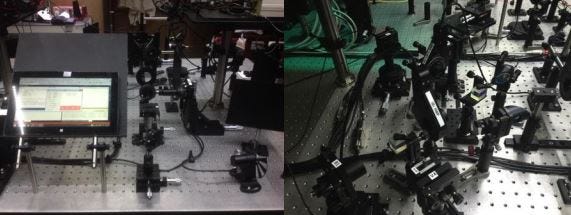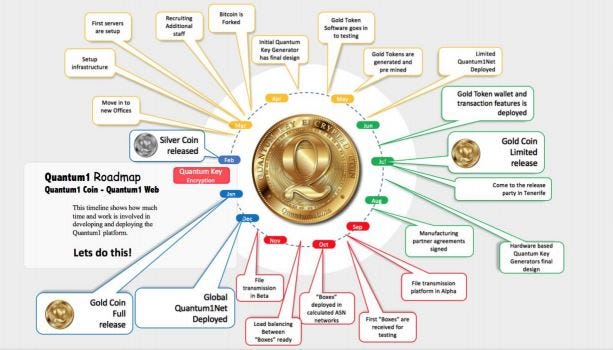
The RSA cryptography platform is now 40 years old. While it has served well in securing the Internet and digital communications, its days are numbered due to the unyielding advance of Moore’s law and the emergence of quantum computing. Significant effort and resources are being employed by hackers to crack RSA and other forms of encryption. The rise of quantum computing makes cracking RSA and various other forms of encryption feasible in the near future. Classical computers use binary bits, which have a value of either zero or one. Strings of these zeroes and ones translate into data, but the nature of the bit means only one calculation can be done at a time. However, with quantum computing, each quantum bit (called a qubit) can both be a zero and one at the same time. This difference means quantum computers can store vastly more data, and do many more calculations per second, making them perfect for code breaking applications. With these quantum computing technologies on the cusp of a breakthrough making the technology ready to crack existing methods of encryption, the time to act is now. Once RSA is cracked, mission critical applications like HTTPS, credit and debit card processing, and government systems face the immediate risk of compromise. The chaos resulting from such a hack would be totally disruptive to the social and economic framework of daily life.
*Quantum1Net Mission*
The Quantum1Net mission is to create enabling and enabling technologies. We have designed a very safe product so you do not have to worry now or in the future about the security of your data. We introduce an unparalleled level of technical innovation, combined with user-connected system design to provide security, ease of use, and ultimate peace of mind.
*Quantum Computing*
Quantum Computing makes it possible for Quantum bits, called qubits to store large amounts of information at the same time need less energy to do so. The result is much better computer capable of running a much more complicated calculation, and much faster than an ordinary computer.
Ordinary computers work by storing data in a series of bits, holding either 0 or 1. String bit lengths store information, but at one time bits can only have one value or other value, so only one calculation. done at one time. Quantum computing works differently. It is based on the unique behavior of subatomic particles to be able to exist in more than one country at the same time.
*End of RSA Encryption*
Electronic communications have been secured by a method known as RSA, named for three researchers who developed this method: Ron Rivest, Adi Shamir, and Leonard Adleman. It takes a large amount of computing power to produce and then takes into account these numbers, something that is not possible with ordinary computing techniques.
The difficulty in doing so is illustrated in a 2009 study. Researchers found that 768 bits (232 digits) spent hundreds of machines and almost two years to crack, while RSA 1024 bit keys took a thousand times longer, and that was the RSA key type the smallest one used today.
Safe and least RSA depends on traditional computational constraints while rapidly expanding technologies and the emergence of quantum computing soon require a new encryption strategy. Much less resources and time needed to break even the strongest RSA keys with quantum computing. Quantum computing empowers first credential threats against RSA encryption from the start.
*Quantum Computing and Code Solving*
Prior to Quantum computers would have a positive effect on the technology industry, their expertise also brought issues of security issues. RSA depends on the complexity of a large amount of factorization to store encrypted data. Due to its architecture, quantum computing becomes a direct solution to this problem.
Because the qubit has the advantage of having a state at the same time called superposition of circumstances, allowing to do a lot of calculations, Quantum computer becomes a logical code-breaking mechanism. Work is underway, and NIST expects a quantum computer capable of breaking RSA2048 in hours by 2030 to be purchased for a cost of about a billion dollars.
*Quantum Encryption Key*
The Quantum Key Encryption Generator is at the core of the Quantum1Net encryption strategy. To review, generate a multi-digit random number from which the mathematical property is derived in case of RSA primary factorization. However there is one major problem, random generators are used only pseudo-random (so-called PRNGs), so RSA keys are pseudo random. Tests show that PRNG shows repetitive behavior patterns when selecting random numbers. This pattern means that with sufficient results, predictions can be made for the selection of the number in the future. That way, PRNG is not really random.
Quantum1Net instead relies on Quantum Encryption Key Generator (QEKG). Due to the nature of the quantum computer itself, tests have shown that in large samples the number chosen does not follow the pattern so that no predictive algorithm can be derived.

This graph shows the results of PRNG and QEKG tests on a sample size of 20,000 bits 50,000 times. By using PRNG, after 50,000 tests, it is seen visually that the data is predictive even after 10,000 or more first experiments. With QEKG however it is not the case. Look at the bottom of the graph where the dots are more dispersed. Unlike PRNG graphs, on the QEKG chart there is no clear pattern to their location.
*Quantum1Net Prototype*

The laboratory prototype of Quantum1Net’s Quantum Random Number Generator, which has been in development since 2014, is based on a one-qbit optical device, that uses four photon detectors and time-to-digital (TDC) converter to generate sets of perfect random numbers with timestamps. The quantum device consists of an entangled photons source, and linear optical elements, which sets the quantum system to the desired state. Two configurations have been developed to generate sets of 4 and 6 elements respectively. The output of the TDC is the temporary queue, from which sets of unique random numbers or encryption keys can be requested, creating a real time, on demand encryption and decryption system.
*Quantum Tokens*
Quantum1Net launches two types of tokens: the first Silver Token that can be converted in February 2018 without quantum key encryption, and unlimited release quantum keys extracted to Gold Token in July 2018. Silver token holders can change their ownership at a discount. The full deployment of Gold Token and Quantum1Net is currently scheduled for January 2019.
*Timeline ICO*
Sales Token # 1: silver token
Ethereum based
February 2018
Convert to Gold Token with 20% off
Sales limit of 15 million
Sales Token # 2: Gold Token
July 2018
Bitcoin-based, including QEK
Silver Token investors get priority
Sales limit of 18 million
Sales Token # 3: Gold Token
January 2019
Bitcoin based, QE activated
Silver Silver Investors converting on July 2018 sales may participate at a 5%
Sales Limit 200 million
*Quantum1Net Roadmap*

Quantum1Net expects to continue development through the first part of 2018. The hiring of additional developers in March 2018 should allow us to finalize development of the initial QEKG the following month, supporting a limited Quantum1Net deployment in May. The final design for the hardware-based Quantum Key Generation should be complete in July, followed by the signing of manufacturing partners by the end of Summer 2018. Fall of 2018 is when we fully expect to start racing towards a global Quantum1Net launch in January of 2019. We expect the ‘alpha’ version of the Quantum1Net file transmission platform initially during September, and a beta version in November 2018. The release version is likely to be completed the following month, which paves the way for the global Quantum1Net release targeted for Q1 2019.
Further information:
Website: https: //quantum1net.com/
WhitePaper: https: //quantum1net.com/Q1N%20white%20paper.pdf
Telegram: https://t.me/Quantum1Net
Facebook: https://www.facebook.com/quantum1net
Twitter: https://twitter.com/quantum1net
Author (iyanfoursix46): https://bitcointalk.org/index.php?action=profile;u=1061980

Komentar
Posting Komentar